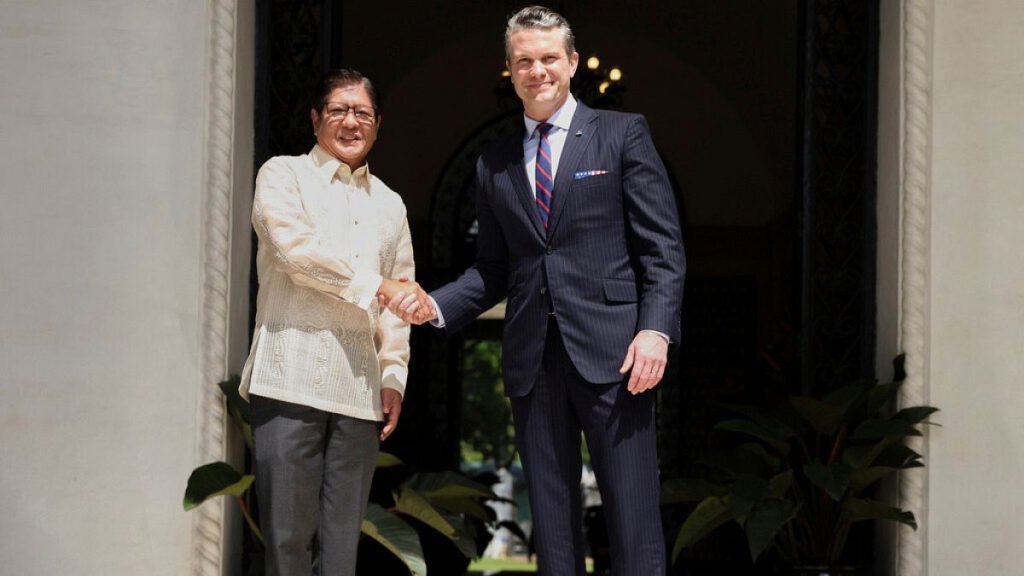The recent visit of US Defence Secretary Pete Hegseth to the Philippines has stirred significant attention, coinciding with growing political pressure for his resignation amid a national security scandal in the United States. During this visit, Hegseth emphasized the United States’ unwavering commitment to counter Chinese aggression in the South China Sea, a region increasingly fraught with tension. His meeting with Philippine President Ferdinand Marcos Jr. underscored the strategic partnership between the two nations as they prepare for extensive joint military exercises.
| Article Subheadings |
|---|
| 1) Background of Hegseth’s Visit |
| 2) US Commitment to the Philippines |
| 3) Rising Tensions in the South China Sea |
| 4) Political Implications in the US |
| 5) Future of US-Philippines Relations |
Background of Hegseth’s Visit
The visit of Pete Hegseth to the Philippines was framed within a context of heightened military and diplomatic engagement in the Asia-Pacific region. Having taken office in June 2022, President Ferdinand Marcos Jr. has sought to recalibrate the Philippines’ foreign policy, moving closer to the United States while distancing from China, which had influenced the country under former President Rodrigo Duterte. Amidst these geopolitical shifts, Hegseth’s visit was pivotal for reaffirming the mutual defence treaty and enhancing military ties.
US Commitment to the Philippines
During his meeting with President Marcos, Hegseth reiterated the United States’ “ironclad” commitment to the Philippines. He emphasized that both nations must work collectively to deter conflicts and secure freedom of navigation in the waters surrounding the archipelago. The US defence secretary remarked, “Deterrence is necessary around the world but specifically in this region, in your country,” pointing to the ongoing threats posed by China. This dialogue echoed a larger strategy by the US to maintain its presence and influence in the face of rising Chinese assertiveness in the contested waters of the South China Sea.
Rising Tensions in the South China Sea
The backdrop of Hegseth’s visit involved increasing tensions in the South China Sea, where the Philippines has expressed concerns over aggressive Chinese military maneuvers. Notably, Manila reported that a Chinese helicopter had dangerously approached a Philippine patrol aircraft near the disputed Scarborough Shoal, raising alarms about the safety of local patrols and highlighting the unresolved territorial disputes. As the Philippines maintains its stance on defending its interests in these contested waters, Hegseth commended the nation’s resolve, stating they have stood “very firm” in protecting their sovereignty.
Political Implications in the US
While Hegseth engaged in diplomatic efforts abroad, his return to Washington was overshadowed by calls for his resignation from various Democrats who cited revelations regarding his use of the Signal messaging app to send sensitive military plans related to Yemen. The leaked messages raised serious concerns about the lives of US military personnel potentially being compromised during operations. Critics argue that Hegseth’s conduct highlights a troubling lapse in national security protocols, adding to the political complications surrounding his visit.
Future of US-Philippines Relations
The significance of Hegseth’s visit extends into the future of US-Philippines relations, particularly as both countries brace for their largest annual combat exercises scheduled for next month. As China has expressed strong opposition to what it views as interference from external powers, the continued partnership between the US and the Philippines faces both strategic opportunities and significant challenges. By aligning closer with the US, the Philippines is seeking to bolster its defense capabilities while managing the complex nature of its interactions with China, which has issued warnings against allowing external influence in the region.
| No. | Key Points |
|---|---|
| 1 | Hegseth’s visit follows a shift in Philippine foreign policy towards greater alignment with the US. |
| 2 | US commitment to the Philippines is underscored by mutual defence agreements amidst threats from China. |
| 3 | Increased Chinese military activity in the South China Sea has raised safety concerns for Filipino forces. |
| 4 | Hegseth faces scrutiny in the US as Democrats call for his resignation over security breaches. |
| 5 | The upcoming combat exercises between the US and Philippines signify deeper military collaboration. |
Summary
The visit of US Defence Secretary Pete Hegseth to the Philippines marks a crucial moment in the evolving dynamics of US-Philippines relations as both nations seek to navigate the challenges posed by an assertive China in the South China Sea. While reaffirming commitments to mutual defense, Hegseth’s visit is also shadowed by political controversies back in the US, raising questions about the efficacy of leadership in national security matters. The cooperation between the US and the Philippines seems set to strengthen in the near future, particularly as they prepare for significant joint military exercises aimed at ensuring regional stability.
Frequently Asked Questions
Question: What is the significance of Hegseth’s visit to the Philippines?
Hegseth’s visit underscores the US’s commitment to support the Philippines amid rising tensions with China, aiming to bolster military ties and strategic cooperation.
Question: How does the current US administration’s approach differ from the previous one regarding the Philippines?
The current administration under President Ferdinand Marcos Jr. has pivoted towards strengthening relations with the US, contrasting sharply with former President Rodrigo Duterte‘s policy of closer ties with China.
Question: What are the ramifications of Hegseth’s political controversies on US foreign policy?
The controversies surrounding Hegseth’s actions and calls for his resignation may complicate diplomatic efforts and may affect the perception of the US’s commitment to stability in the Asia-Pacific region.


